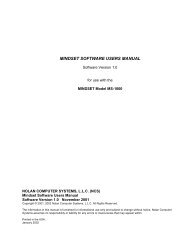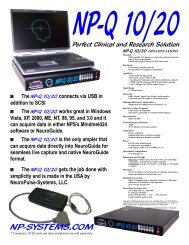MS-1000 Hardware Manual
MS-1000 Hardware Manual
MS-1000 Hardware Manual
You also want an ePaper? Increase the reach of your titles
YUMPU automatically turns print PDFs into web optimized ePapers that Google loves.
Appendix V - Additional SCSI Issues<br />
Background<br />
The SCSI bus is a resistor terminated and high current bus. The termination resistors (or block) do two<br />
things:<br />
• they help match the characteristic impedence of the SCSI bus wires to the input circuitry,<br />
thus preventing the signals from reflecting and ringing.<br />
• termination power is applied through the resistors to pull the voltage on the wires up<br />
to at least 2.8 volts.<br />
A high (2.8 to 5.0) voltage on the bus wires represents the inactive or zero state. A signal is driven<br />
active by driving the voltage to below 0.7 volts.<br />
Without termination power, all of the wires on the bus would remain at zero volts and no communication<br />
would be possible. Without termination resistors, signals on the bus are not at their proper voltages and<br />
can cause ringing and unreliable operation. Therefore, both termination power and termination resistors<br />
are necessary. Most SCSI devices are designed to provide termination power, including Mindset.<br />
Unfortunately, high current on the SCSI bus leads to strong magnetic fields being generated. These<br />
magnetic fields in turn create voltages in wires that they cross. Mindset’s amplifiers are very sensitive<br />
and can pick up these minute signals. The goal is to minimize these signals.<br />
Noise Intrusion<br />
Depending upon several factors (such as sample rate, SCSI bus termination, SCSI bus configuration,<br />
etc.), it is possible for SCSI bus noise to intrude upon EEG data. This noise usually shows up as a<br />
spurious 2, 4, 8, 16 or 32 Hz signal. This is because MindLab may be transferring data from the<br />
Mindset hardware at these intervals and the SCSI bus has heavy activity then.<br />
The noise is best seen by taking a minute or two of data without any connections to Mindset’s front<br />
panel. If you observe such noise, try setting the block size to a smaller value (refer to the software<br />
manual for instructions). This forces MindLab to access Mindset at a higher rate (because the same<br />
amount of data is transferred each second). The idea is to make this access rate higher than 32 Hz,<br />
moving it out of Mindset’s passband.<br />
For example, assume you are sampling at 256 sps and the SCSI block transfer size is set to 512 bytes.<br />
Every second, there are 8,192 bytes of data transferred across the SCSI bus:<br />
256 samples/second * 2 bytes/sample * 16 channels = 8,192 bytes/second.<br />
Since MindLab grabs these data in 512 byte blocks (the SCSI block size), the access frequency from<br />
MindLab to Mindset is 8,192 / 512 = 16 accesses per second. Under some circumstances this may show<br />
up as a spurious 16 Hz signal in the EEG data.<br />
25




